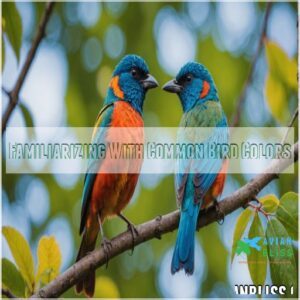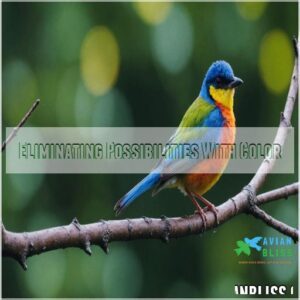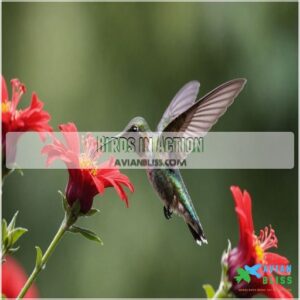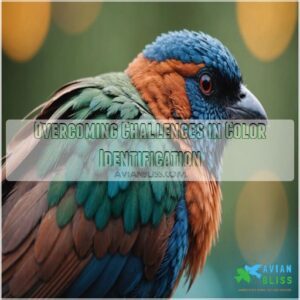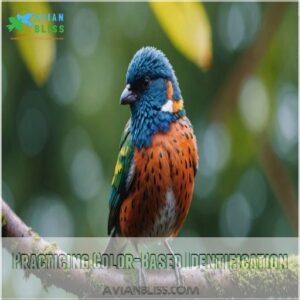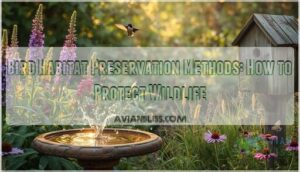This site is supported by our readers. We may earn a commission, at no cost to you, if you purchase through links.
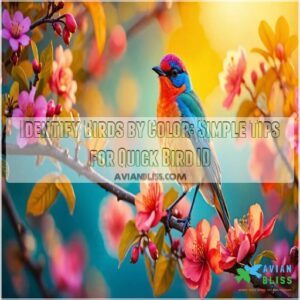
Start by noting the overall color patterns, from bold markings to subtle shadings.
Look for distinctive features like white flashes on tails and wings – these are often key identifiers for species like nuthatches and redstarts.
Pay attention to light and dark patterns in flight silhouettes, and don’t forget to think about how seasonal changes affect plumage.
Think of bird colors as nature’s fingerprints: unique combinations that tell a story.
Just remember that lighting conditions can play tricks on your eyes, making that "definitely purple" finch look surprisingly different in full sunlight.
Table Of Contents
- Key Takeaways
- Color Patterns in Birds
- Identifying Birds by Overall Color
- Key Distinguishing Features
- Birds in Action
- Overcoming Challenges in Color Identification
- Practicing Color-Based Identification
- Frequently Asked Questions (FAQs)
- Is there a website to identify birds?
- How can I identify a bird I took a picture of?
- What is the best free bird identification app?
- How do I identify a specific bird?
- How does artificial light affect bird color identification?
- Can weather conditions change a birds apparent colors?
- What role do seasonal molts play in coloration?
- How reliable are photos for identifying bird colors?
- Why do male and female birds have different colors?
- Conclusion
Key Takeaways
- Focus on overall color patterns, distinctive features, and light/dark contrasts to quickly narrow down bird species.
- Consider seasonal changes, lighting conditions, and individual variations that can affect a bird’s apparent coloration.
- Combine color observations with other factors like size, shape, bill structure, and behavior for more accurate identification.
- Practice regularly using field guides, apps, and local birdwatching groups to improve your color-based identification skills over time.
Color Patterns in Birds
You’ll find that understanding bird color patterns is key to quick identification.
Pay close attention to details like arrangement of light and dark areas, the boldness of markings, and any striking white on wings or tails.
These clues will help you narrow down possibilities.
Common Light and Dark Patterns
Spotting birds involves noticing light and dark patterns, a black bird with white stripe on wing, a combination that’s all about the right shadow effects and color contrast.
Imagine bird silhouettes as they fly; light reflections and dark patterns can reveal a bird’s identity.
This field mark, along with the overall color pattern, help you identify birds by color, turning fleeting glimpses into vivid memories.
Bold and Faint Markings
When identifying birds, pay attention to bold and faint markings like nature’s own brushstrokes.
These markings, which can vary by age and species, signal important clues in bird identification.
For example, while vibrant stripes or spots might catch your eye, don’t overlook subtle shadings.
These can reveal insights into a bird’s habitat and behavior, enhancing your understanding of its colorful world.
White Flashes on Tails and Wings
Once you’ve grasped the art of bold and faint markings, turn your attention to spotting white flashes on tails and wings.
These bright cues, like a white-breasted nuthatch’s tail or an American redstart’s wing, guide your eyes.
Field guide examples show how color variations in tail patterns can help identify species, particularly when distinguishing between year-round residents like those found among the red birds in Florida red birds in florida. Field guide examples show how color variations in tail patterns can help identify species like the American robin or northern cardinal.
Identifying Birds by Overall Color
Identifying birds by their overall color is an essential technique for any birder, allowing you to quickly build a hunch about a bird’s identity.
By familiarizing yourself with common bird colors, patterns, and distinctive markings, you can eliminate many possibilities and enhance your birdwatching skills.
Familiarizing With Common Bird Colors
Color patterns set the stage, leading to familiarizing yourself with common bird colors.
It’s like discovering nature’s palette.
Picture bright western tanagers, a splash of red-headed woodpeckers, the striking hues of purple finches and house finches.
The mountain bluebird’s sky-blue tones enchant, showcasing how fascinating bird color variations can enrich your birdwatching experience across different regions.
Using Color to Build a Hunch
Spotting a bird’s overall color helps you make quick educated guesses about its identity.
Light and dark variations, like those seen on golden eagles and bald eagles, guide you.
Here’s how to build your hunch:
- Observe feathers as clues.
- Note seasonal changes.
- Watch for bird mimicry.
- Consider camouflage.
These steps enrich your bird watching!
Eliminating Possibilities With Color
Bird identification often starts with noticing a bird’s overall color.
This helps narrow down possibilities.
For example, herons offer a great illustration of color-based elimination.
| Heron Type | Main Color | Bill Structure |
|---|---|---|
| Great Blue Heron | Blue-gray | Long, straight |
| Little Blue Heron | Dark bluish-gray | Long, straight |
| Green Heron | Greenish-brown | Shorter, thicker |
Using a field guide, you’ll quickly eliminate options based on this initial assessment.
Remember, similar color patterns can be tricky, so pay attention to details!
Key Distinguishing Features
To identify birds accurately, focus on key features like the size and shape, bill structure, and distinctive plumage patterns.
These structural aspects, such as the head and body’s features, offer important clues that complement color-based identification efforts.
Size and Shape of Birds
Thinking about bird colors, it’s also useful to notice size and shape.
Watch how a bird’s proportions hint at its species—a bit like recognizing a silhouette in a lineup.
Compare wingspan and body structure with nearby birds, and for a more detailed guide on bird identification, check out this color bird guide.
How a bird moves in flight, like a well-rehearsed dance, can also be influenced by its unique characteristics, such as the striking coloration of small black and white birds, which can guide you in identifying bird songs and calls by ear.
Bill Structure and Plumage
You’ve considered size and shape, now let’s eye bill structure and plumage for clues.
Each bird’s beak tells a story; compare a song sparrow’s tapered bill to the hefty one of a rusty blackbird.
Plumage variations, like the understated hues of dark-eyed juncos, can signal distinct species.
Look for feather patterns and color combinations for reliable identification.
Structural Features of The Head and Body
From analyzing bill size and plumage, your birding skills now broaden as you check neck length and leg length.
Notice how the head shape distinguishes a Cooper’s hawk from a sharp-shinned hawk, and don’t forget that bird identification by sight also involves considering body proportions, silhouette, wingspan, and tail length.
MacGillivray’s warbler’s body proportions also stand out.
Keep these features in mind, and you’ll soon spot the differences like a pro, adding mastery to your bird identification toolkit.
Birds in Action
In observing birds, you’ll find that their flight patterns and feeding behaviors can reveal as much about their identity as their colors do.
By watching how they move, eat, and interact with their surroundings, you can add important clues to your bird identification toolkit.
Identifying Birds by Flight Patterns
Spot birds in action by watching their flight patterns like you’re piecing together a mystery.
Notice wing shape, wingbeat cadence, and flight posture.
Listen for unique flight sounds, often captured in bird sighting records or noted during bird vagrancy studies.
Imagine American white pelicans’ graceful glides or snow geese’s structured formations as you hone your birding practices.
- Watch
- Listen
- Compare
- Record
Observing Feeding Habits and Postures
Get started with bird identification by observing feeding behaviors and postures!
Notice how a bird holds its body—is it upright like a Lincoln’s sparrow, or more horizontal like a northern shoveler?
Different feeding techniques, from the pelican’s plunge-diving to the ring-necked duck’s dabbling, reveal clues about their diet and habitat.
Consider their posture while feeding; this adds another layer to identifying birds by action, helping you distinguish between species.
Even the way a red-winged blackbird perches can be a key identifier!
Behavioral Traits of Flying Birds
While observing a bird’s feeding habits is insightful, watching them in flight offers a vivid picture of their personality.
Note the flight patterns and wingbeat cadence. Admire aerial acrobatics and consider wing shape and gliding techniques.
Whether it’s a Lincoln’s sparrow gracefully chattering away or a Green Jay showing off, notice their distinct behaviors—a key to quick identification.
Overcoming Challenges in Color Identification
Bird color identification can be tricky; variations in lighting, distance, and plumage among individuals may throw you off.
Don’t worry, though—understanding these challenges will help you differentiate birds with similar color patterns more effectively.
Accounting for Lighting and Distance
With lighting variation creating tricky shadow effects, don’t let distance distortion fool you; it can throw off your color perception.
Sometimes, that flash of red might just be a trick of the light, not a cardinal.
Background influence also plays a part—bright skies or shady forests shift hues.
Watch closely, and you’ll start seeing true bird colors.
Dealing With Individual Variation in Plumage
You’ve adjusted for lighting, but now you’re faced with plumage variations.
Birds aren’t clones; age differences, molting stages, and sex differences create colors as mixed up as a box of crayons.
Hybrids add to the paint palette too.
When a bird stumps you, consider these factors.
Each bird paints its story differently, offering subtle clues for identification.
Identifying Birds With Similar Color Patterns
Spotting birds with similar color patterns adds a twist to your birding quest.
Differences in juvenile plumage, color-based confusion, and mimicry can mislead even seasoned birders.
Trust your tools—field guides and apps—can be lifesavers here.
Watch for:
- Mimicry and deception tricks
- Hidden regional variations
- The challenge of juvenile plumage
- Use of reliable field guides
Stay patient, and you’ll succeed!
Practicing Color-Based Identification
You’ll build confidence in bird identification by focusing on common color patterns of local species, such as the distinctive black plumage of the American Crow species, starting with quick reference guides and gradually moving to field observations.
You can head to a nearby park or backyard feeding station where you’ll practice spotting distinctive markings like wing bars, tail patterns, and head colors when you’re ready to test your skills.
Developing Skills Through Practice and Experience
Regular practice sharpens your bird identification skills like a well-honed field lens.
Utilize color identification guides to improve your skills.
Join local birdwatching groups for guided field trips where experienced birders share their wisdom.
Use bird ID apps to test your knowledge, and connect with online communities to discuss tricky identifications.
These learning resources help build confidence, turning those fleeting glimpses into accurate IDs through hands-on experience and shared knowledge.
Using Quick ID Guides and Field Observations
Mastering color-based bird identification often starts with spotting species like the blue and white birds, which represent freedom and purity in many cultures. Mastering color-based bird identification often starts with Quick ID guides that spotlight common bird shapes and behaviors.
When identifying bird species, users often find it helpful to learn about the different types of birds they may encounter, and a great place to start is by exploring resources that offer tips and tricks for quick bird ID, like the ones you’d discuss over coffee with a pal. These guides can be especially helpful when identifying species like the vibrant blue and birds with bright colors birds.
Pair these tips with field observations for a richer experience, taking note of specific characteristics such as the Eastern Bluebird‘s vibrant blue head and orange throat and chest found in blue and yellow birds.
When trying to identify birds by their colors, keep in mind that species like the Eastern Bluebird can have distinct blue plumage, and learning about Florida’s diverse bird species. Embrace bird identification apps and watch for seasonal variations that affect colors.
Blend field guide tips with those insights, and you’ll soon spot differences even in similar-looking birds, enhancing your identification skills.
Frequently Asked Questions (FAQs)
Is there a website to identify birds?
You’ll find eBird, Merlin Bird ID, and iNaturalist incredibly helpful – they’ve got extensive databases where you’ll snap photos, record sounds, and get instant bird identifications from experts worldwide.
How can I identify a bird I took a picture of?
Upload your bird photo to a bird identification app or website. Many offer detailed analyses based on plumage, shape, and location. You’ll quickly get a likely species ID!
What is the best free bird identification app?
Like a bird-spotting superhero, you’ll find Merlin Bird ID by Cornell Lab outshines competitors with its instant photo ID, sound recognition, and detailed database.
It’s completely free and works offline for your adventures.
How do I identify a specific bird?
Look for key features: size, shape, color patterns, and behavior.
Take note of the bird’s habitat and season.
Listen for distinctive calls or songs.
Use a field guide or birding app to compare your observations and narrow down the species.
How does artificial light affect bird color identification?
Artificial light distorts, alters, and misleads.
It can shift hues, wash out details, and create false impressions.
You’ll see reds dulled, blues brightened, and shadows deepened.
Trust your eyes in natural light for accurate bird color identification.
Can weather conditions change a birds apparent colors?
Weather conditions can indeed alter a bird’s apparent colors.
You’ll notice changes in brightness and hue during overcast days, rain, or intense sunlight.
Wet feathers may appear darker, while strong light can wash out subtle shades, challenging your identification skills.
What role do seasonal molts play in coloration?
Seasonal molts transform birds’ appearances, replacing worn feathers and adapting colors for breeding or camouflage.
You’ll notice dramatic changes in some species, like goldfinches turning bright yellow in spring.
It’s nature’s way of dressing birds for success!
How reliable are photos for identifying bird colors?
Photos can be useful but not always reliable for bird color identification.
Lighting, camera settings, and screen calibration can affect perceived colors.
You’ll get better results by combining photos with field observations and guidebook descriptions.
Why do male and female birds have different colors?
Like nature’s fashion show, male and female birds often sport different colors.
Males’ vibrant plumage attracts mates and signals dominance, while females’ muted hues provide camouflage during nesting.
This sexual dimorphism plays a key role in avian reproduction and survival.
Conclusion
While identifying birds by color can be challenging, it’s also incredibly rewarding.
Remember, practice makes perfect.
As you hone your skills, you’ll discover that color is just one piece of the puzzle.
Combine it with other factors like size, shape, and behavior for a more accurate ID.
Don’t get discouraged if you make mistakes – even seasoned birders sometimes struggle.
Keep observing, learning, and enjoying the colorful world of birds.
With time, you’ll be amazed at how quickly you can identify birds by color and more.


